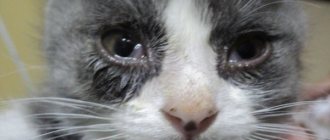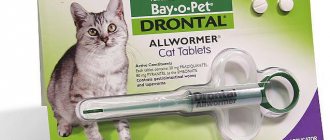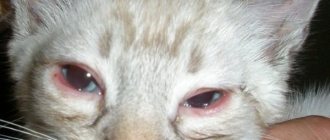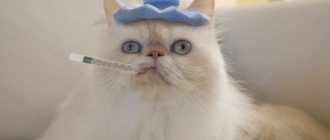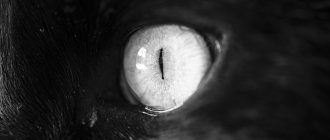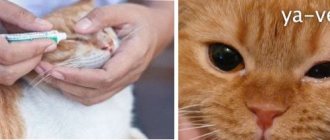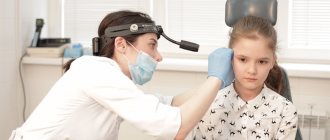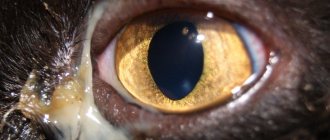What can lacrimation in cats signal? With a high probability, this indicates that some deviation from the norm has occurred in the animal’s body. Therefore, if you are faced with the fact that your pet has one eye squinted or watery, it is advisable to go to the hospital for an examination and consultation with a veterinarian. Of course, you shouldn’t panic right away, since lacrimation is not always a threat. Next, we will try to understand the reasons that can cause tears in cats, and also focus on the main options for diagnosis and treatment at home.
The animal's eyes are watery: reasons
Tearing can occur either from natural causes or as a result of illness.
In the first case, tears from the eyes may appear:
- After the furry animal woke up. This is a normal reaction of the body. The cat removes traces of tears itself by washing its face. For kittens, you can wash their eyesight with a swab moistened with boiled water.
- If the cat belongs to a certain breed. The Persian, the British, the Sphinx have tears and a peculiarity of the body. Persians are too fluffy, and doctors often diagnose the Sphynx breed with a disease called “entropion.” In this case, the animal can only be cured by resorting to surgery.
- If hair fibers get on the cornea. This symptom often occurs in long-haired small carnivores. The only thing that will help your cat is regular eye care.
In the second case, the cat may cry due to:
- Mechanical damage, injuries. A pet can damage the eyelid, eye, or cornea in a confrontation with another representative of its breed, during play or a walk. A sharp blade of grass or a twig that scratches the organ of vision can cause serious inflammation.
- Foreign objects. A small speck, a piece of tree bark, or a piece of plastic is enough to cause an inflammatory process to develop in a cat’s eye. Treatment in this case includes procedures for treating with solutions of antibacterial drugs.
- Burn. Curious animals often stick their noses into everything they find at home. Aggressive household chemicals, solvents, and wood varnish can become an object of curiosity, which will lead to a chemical burn. A pet can get a thermal burn if it becomes interested in cooking in the kitchen.
- Allergic reaction. Allergies are the scourge of the modern world; not only people, but also animals are susceptible to manifestations of allergies to various irritants.
- Incorrect eyelash growth. Sometimes a cat has a pathology - the eyelashes grow incorrectly, causing the pet a lot of suffering: the eyelid is inflamed, tears constantly ooze. In this case, the help of a veterinarian is required.
- Helminth infections. One of the signs of the disease is increased production of tears.
- Conjunctivitis. The infection is caused by chlamydia; only a veterinarian can cure the little predator.
- Colds. A cat often cries if it has a cold.
Be sure to read:
A cat sniffles through its nose: reasons, what to do when it is normal, sniffling is a sign of disease
How to distinguish dangerous lacrimation from non-dangerous ones
With pathological
When your cat has watery eyes, problems appear in one or both eyes. The discharge is thin or mucous, brown or slightly whitish.
The nature of the discharge can vary from liquid and transparent to thick, purulent. Typically, pathological lacrimation is accompanied by the animal's anxiety and itching: the cat constantly washes itself and rubs its eyes with its paws.
Body temperature may rise, red eyes, and swelling of the eyelids may appear. Crusts form in the corners of the eyes and hair falls out. When only one eye is watery, the cat squints it and rubs it with its paw. Pathological lacrimation may be accompanied by lethargy of the pet, poor appetite and other signs of illness.
With a sick animal, you should go to the veterinarian to get advice, understand the causes of the disease and take all necessary measures. Timely treatment will help avoid dangerous complications such as infection and blindness.
Tearing in cats can also occur due to
natural
causes. For example, after sleep one eye waters and does not open. This is not dangerous: the eye should be rinsed with boiled water or chamomile decoction.
Long-haired cats often have excessive tearing due to hair getting into the tear duct and the accompanying irritation. Breeders are advised to trim the long hair on the face of a long-haired cat and brush the pet regularly.
Due to the anatomical features of the structure of the skull and the short nasolacrimal ducts in the British, Scots and Persians, lacrimation is a normal variant. These cats cry almost constantly without experiencing any discomfort. Breeders of such cats need to take good care of their pet’s hygiene and periodically treat their eyes and face.
A cat's eye is watering: what to do?
Excessive production of tears from one eye requires immediate action on the part of the owner:
- Assessment of general condition. It is necessary to conduct a visual inspection, measure body temperature, and examine the cat for injuries.
- Treatment of the affected eye with furatsilin (solution), decoctions of medicinal herbs.
- A trip to the veterinary clinic.
During treatment, a number of rules should be followed:
- Rinse both healthy and affected organs of vision.
- Remove the allergen from the home if an allergic reaction is diagnosed.
- When treating an infection, lubricate the eyes with ointments 2 times a day.
- If surgery is required, do not remove the special collar from the cat until complete healing.
First aid and treatment
To completely cure an animal, you need to make a correct diagnosis. Treatment is usually carried out using drops and ointments, and immunity-supporting drugs are often included. Before determining the cause of lacrimation, you can clean the animal’s eyes yourself, using napkins or cotton pads. They should be moistened:
- chlorhexidine solution;
- infusions of herbs, such as chamomile or sage;
- boric acid solution (2%).
Such cleaning will not help cure the animal, but it will make the pet’s condition easier if its eyes stick together due to secretions, interfering with orientation in space.
A veterinarian will tell you how to properly care for your pet’s eyes in her video from Lina Vet’s Vet Tips channel.
Medicines
The doctor decides how to treat the animals after an examination: you should not do this yourself, because it can cause harm. So, little kittens can not do everything that is freely prescribed for adult animals. Eye drops such as:
- "Leopard";
- "Diamond Eyes";
- tsiprovet;
- anandin.
The last of the drugs stings noticeably, so the kittens scratch their eyes and get worried after the procedures. For bacterial conjunctivitis, it is recommended:
- chloramphenicol;
- kanamycin;
- sodium sulfate;
- sofradex (contains a hormone and is not recommended for corneal damage).
But, it is worth emphasizing that in case of allergies, none of the drugs listed will help - you will only torture the animal in vain. For proper treatment and advice, you should contact a veterinarian.
Traditional methods
If a cat’s eye is leaking, then treatment with folk methods, at best, can only help cleanse the organ of vision, preventing infection from developing. With already developing inflammation, this method of fight is unlikely to help. Experts recommend cleansing with decoctions of useful antiseptic plants: chamomile, St. John's wort, sage.
Diagnosis of inflammation of the trigeminal nerve
Depending on the affected area and the set of symptoms, the strategy for diagnosing the disease is determined. To determine the location of nerve damage, the severity and dynamics of recovery, doctors prescribe a hardware diagnostic method, for example, electromyography. MRI and CT scans are used to determine the presence of tumors in the brain.
The patient may also be referred for a general or biochemical blood test, x-ray of the lungs, ultrasound of soft tissues or ophthalmoscopy.
You can be confident in the quality of the procedures performed in the clinic and the high accuracy of the results of MRI, CT and other methods of diagnosing various diseases. Medunion performs magnetic resonance imaging of all types: head, spine, abdominal cavity and joints using modern equipment.
Symptoms of the condition
To distinguish physiology from pathology, the owner needs to know a number of clinical signs indicating that the pet has health problems. The most characteristic symptoms are:
- Lack of appetite in the animal, lethargy and general malaise.
- An increase in both general and local temperatures.
- Redness, swelling of the eyelids and conjunctiva of one or both eyes.
- There may be severe itching in the eyelid area.
- Profuse lacrimation.
- The presence of purulent exudate (discharge), which dries and subsequently forms crusts around the sore eye.
- Hair loss in the eyelid and nose area.
Prevention measures
It is impossible to completely eliminate the risk of viral and bacterial infections and colds for a domestic cat. But with the help of basic preventive measures, this danger can be significantly reduced.
The proposed rules are not onerous, but very effective:
- regular visits to the veterinarian;
- strict adherence to the vaccination schedule;
- timely implementation of antiparasitic measures;
- exclusion from the menu of products that cause unwanted reactions;
- regular wet cleaning, timely cleaning and washing of the cat bed;
- Protecting your cat from hypothermia and drafts.
After bathing, many owners dry their pet's coat with a hairdryer. In this case, it is necessary to ensure that the air is not too hot. You should not direct the air stream into the cat's face - this can cause drying of the nasal mucosa and snot.
Even the strictest adherence to preventive measures will not provide unambiguous protection against diseases, therefore, if signs of illness appear, it is necessary to observe the behavior and well-being of the cat and consult a veterinarian. You should not wait long, as this may prevent the start of effective treatment.
I like3I don't like
Establishing diagnosis
Before starting treatment, it is imperative to conduct a diagnosis that will help identify the true cause of excessive lacrimation and carry out effective treatment therapy. Only a veterinarian can conduct a correct and thorough examination.
Important! Before going to the veterinarian, be sure to prepare a pet card, which should indicate all vaccinations, anthelmintic treatments, and past illnesses. It is advisable to write down symptoms of malaise and other suspicious signs on a piece of paper.
Sometimes the veterinarian may be interested in the following important questions at the appointment:
- how long the symptoms last;
- how did the first symptoms of tearing from the eyes appear and the peculiarities of the course of this condition, for example, did two eyes immediately begin to water at the same time, or vice versa, first one began, and then the other, and whether there are other additional symptoms;
- when the last procedures to eliminate helminths, fleas, ticks and other parasites were carried out.
To make an accurate diagnosis, the veterinarian will definitely take a urine and stool test. It is advisable to already have the research material with you before going to the doctor. Also, at the appointment, he will definitely take mucus from the eye for examination; for this reason, there is no need to first rinse the pet’s eyes with various solutions.
Causes of inflammation of the trigeminal nerve on the face
Usually the disease is caused by infection or bacteria. List of reasons why inflammation of the facial nerve may occur:
- Temporomandibular joint injuries
- Tumors (benign and malignant) of the brain and facial area
- Anomalies of skull development
- Skull injuries - birth, fracture, base, damage to the face or jaw
- Polio
- Pulmonary tuberculosis
- Otitis
- Sinusitis
- Chronic caries
- Inflammation after tooth extraction or treatment
- Hypertension
- HIV and AIDS
- Poisoning
- Inflammation of the middle ear
- Severe hypothermia of the head
- Changes in hormonal levels in women
- Gum inflammation
- Ramsay Hunt syndrome
- Stroke
- Bell's palsy
Causes range from minor to life-threatening illnesses. Each of the reasons determines the further treatment of the patient. In some cases, special tests are performed for diagnosis - auditory, lacrimal, infectious, salivary or gustatory. In this way, the functioning of the receptors and sensory organs is checked.
